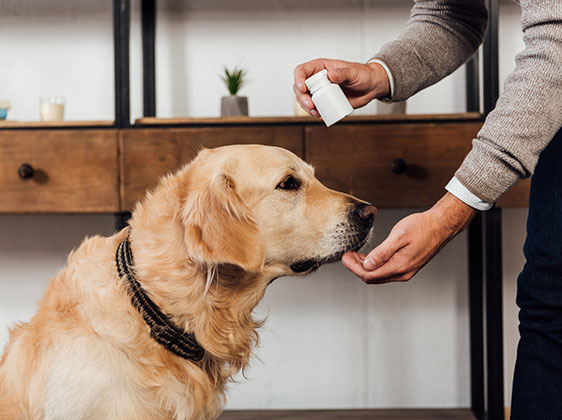By the way, we only suggest products that we believe benefit our community of dog owners. Any links on this page that lead to products on Amazon are affiliate links and I earn a commission if you make a purchase.
Let’s start with the most common question:
Is it safe to exercise a dog with painful joints?
The good news is that as long as you encourage exercise that doesn’t aggravate the dog’s painful joints, it’s perfectly safe to allow your dog to exercise. In fact, it’s recommended.
When your dog is showing signs of arthritis, do warm-up movements with him, just as you would do yourself before weight lifting or cardio.
Joint pain can make a dog reluctant to get up and run about, compounding the problem. Try to make the activity fun for them and exciting.
It’s widely believed that, in many cases, dogs that don’t exercise suffer more with the effects of canine arthritis than dogs that remain active despite their condition.
Modify your dog’s exercise to a low impact pace.Try activities like slow walks around the park, or take your dog for a swim. Moderate exercise increases blood flow and mobility in the joints which encourages healing in the inflammed areas.
Important Note: We recommend consulting with your vet before beginning any new exercises so you can be confident your dog is medically well enough to take part in such activities.
Why does arthritis in dogs occur?
Arthritic dogs typically have very thick cartilage at the joints which rubs together as the muscles move. This eventually wears down through friction.
As cartilage becomes damaged, the body’s natural response is to create inflammation and swelling in the area to protect against further destruction. And so the inflammatory cycle begins and creating further joint pain.
Does exercise help or make arthritis worse?
Studies have found that regular and moderate running exercises in young dogs can reduce cartilage thickness by an estimated 6%*, which reduces the risk of ‘damage by friction’ in old age.
It’s also reported that ‘moderate running exercise locally alters the biological properties of young articular cartilage’*, which means that medium intensity exercises can beneficially affect the status of a dog’s cartilage.
Find more on these studies in the resources section at the end of this article.
You might be concerned that medium and high-intensity exercise, especially weight-bearing exercise, is detrimental to dogs in the long term. Our investigation into the safety aspects of exercise for older dogs and those with arthritis confirmed that these activities don’t lead to premature damage* of the joints or muscles, or accelerate cartilage degeneration.
Keeping your dog active is considered one of the best ways of reducing the risk of dog joint pain in the future.
What’s the best exercise for arthritic dogs?
The exercise regime is a little different to standard exercises for dogs. A young, fit, healthy dog will love to race around, to chase balls, or dig in the sand. But exercise for a dog with inflammation should be much lower in impact to avoid putting any additional strain onto the painful joints.
By low impact exercise we mean taking your dog for slow to moderate walks and swimming.
Gently moving your dog’s legs, or encouraging him to stand up and move around the house, helps to loosen stiff muscles so your dog will be more responsive to other exercises.
Moderate walking and swimming activities increase blood flow and joint mobility without irritating the area causing more pain. In fact, light exercise encourages healing in the inflammed areas.
Overweight dogs
If arthritis is caused by a dog being overweight or obese, low impact exercises promote weight loss, strengthen muscles, and assist the dog to get fitter without risking joint damage. The more weight that’s lost, the less the dog is affected by obesity-related arthritis.
It’s about keeping up a routine and not allowing for long periods of inactivity when muscles and joints have time to stiffen.
Although your dog might not seem as eager to go for a walk as he once did, short, frequent exercise can lessen pain and slow deterioration.
The key is to encourage exercise at regular intervals. But at a much lower level and intensity and for a limited time.
What other ways can I help my dog’s pain?
1. Food for senior dogs
Make sure the nutritional value in your dog’s diet is optimised to meet the needs of an old dog and the particular issues he faces.
2. Hip and joint supplements
Address joint health and support repair with natural, easy to administer supplements to get your best friend moving again.
They act in multiple ways to increase mobility by adding
- nutritional support for maintaining muscle
- lubricating joints
- support for the connective tissue, and
- soothe joints.
Daily supplements for healthy joint function and flexibility contain ingredients like Omega 3 oils, glucosamine, DHA and EPA.
These well known ingredients are essential building blocks for parts of the joints like cartilage, ligaments and the fluids that surround joints. They help prevent the structure breaking down further while supporting joint repair.
3. Heated dog bedding
Warmth is soothing for painful joints. Heat encourages good blood flow. Heat is necessary to lubricate weary limbs and hips to carry vital nutrients to where they’re needed most to accelerate healing and carry away the toxins.
Warmth helps to stop joints stiffening up. You might notice the difficulty your dog has with stairs or getting up after laying down or sleeping. Your dog gets pain relief from warmth and having a deep softness to nestle into.
Self Warming Dog Bed
We recommend a bed with sherpa lining like our Australian Made Choozy range of dog beds. Sherpa is warm, soft, washable and cosy. It’s a perfect alternative to wool or sheepskin and it has the same insulating qualities while drawing moisture away so skin stays dry.
Electric Heated Dog Bed
An electric heated bed in cold weather is a joy for a dog with arthritis to enjoy heat on his joints.
Dog Blanket
A dog bed blanket is perfect for laying down on your dog’s favourite lounging spaces.
Whether it be on the couch, an extra layer to add to his bed in winter, or in the car. We found the Furhaven blankets tick all the boxes.
With a layer of sherpa fleece one side, terry fleece the other and a thermal insert layer it’s self-warming. No electric cords. And it’s water-resistant due to the waterproof interior coating.
Use it as a throw over your favourite couch, You’ll have peace of mind your couch is protected from accidents.
Did I mention it’s machine washable? CHECK HERE FOR A PRICE.
As dog owners, we all want what’s best for our pets. It’s hard to encourage a dog in pain to exercise. But it’s important to remember that helping them build up and straighten their muscles helps lessen the debilitating effects of arthritis in the long term.




